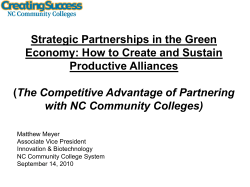
Helping students mature: post-secondary education in Quebec at the CEGEP educational level
Helping students mature: post-secondary education in Quebec at the CEGEP educational level Bernard R. Hodgson Département de mathématiques et de statistique Université Laval, Québec, Canada Plenary panel — CBMS Forum on The First Two Years of College Math: Building Student Success Reston VA October 7, 2014 1 Education is a provincial responsibility in Canada Population (July 2014) Québec: 8 215 000 Canada: 35 540 000 2 “CEGEP” is a French acronym “Collège d’enseignement général et professionnel” General and Vocational College “cégep” — now accepted as a bona fide noun “cégépien” = CEGEP student CEGEPs belong to ISCED level 4 — “Post-secondary non-tertiary education” An instance of “an institution that straddles the divide between secondary education and tertiary education” (World Bank) UNESCO International Standard Classification of Education (ISCED 2011) 3 Structure of the educational system (province of Québec) AGE 5 – 11 Primary school (K + 6) AGE 12 – 16 Secondary school (5!!!) AGE 17 – 18 / 19 CEGEP (2 / 3) AGE 19 – 22 / 23 University (3!!! / 4) Age as of September — start of schoolyear 4 Structure of the educational system (province of Québec) CEGEP network Pre-University programs: 2 years Technical programs: 3 years throughout Québec (launched in 1967) Most programs: 3 years!!! Some exceptions: 4 years (engineering, primary/secondary school teachers) AGE 17 – 18 / 19 CEGEP (2 / 3) AGE 19 – 22 / 23 University (3!!! / 4) Age as of September — start of schoolyear 5 PLAN OF MY PRESENTATION quintuple A quadruple perspective on the CEGEP: • a historical perspective • a systemic perspective • a student perspective • a teacher perspective • a personal perspective Herb Clemens (yesterday): • “student centered” • “exemplary” 6 OF COURSE my aim today IS NOT to “export” the “CEGEP model”… • interest for some of you to hear of this peculiar system which, while far from “perfect”, has definitely shown its merits and impacted very positively on education in Quebec • links with the “community college” model — but substantial differences, vg the CEGEP system is the only possible path in Quebec I will speak very little about math in this panel (“system”) — breakout session! 7 I- A historical perspective 1960s – period of intense changes in Quebec Quebec’s “Quiet Revolution” a multifaceted phenomenon — secularization of society influence / control of the Roman Catholic Church on health (hospitals) and education 1961-1966 Royal Commission of Inquiry on Education in the Province of Quebec “Parent Commission” Mandate: • democratization of education • search for quality education 8 Parent Report — 5 volumes (1963–1965) Complete rethinking of the Quebec’s education system — in particular: creation of the CEGEP system “The Parent Report has incarnated two aspirations of Quebec in his days: entry into modernity and secularization of society.” (Guy Rocher) Parent Commission 9 Before the Parent Report Many weaknesses in education in Quebec (and especially among the Francophone population) • 1950: average number of schooling years < 8 average age of full school attendance < 12 • substantial progress from 1950 to 1961 — but still low (level of schooling for Francophones much lower than in Ontario or USA) Rate of school attendance 10 Before the Parent Report (cont’d) • upper secondary education for Francophones split up -- source of confusion for pupils -- lack of vision / division into “knowledge universes” (scientific, commercial, general, technical, “classical”) • classical colleges — preparation of the “elite” based on a French model (16th century) brought to Quebec by Jesuits (1635) centered on humanities (French, Latin, Greek, Philosophy) THE (almost only) entry door to university!!! Most classical colleges were private and belonged to religious orders 11 Before the Parent Report (cont’d) Difficulty of access to higher education (1964-65 data) Primary course boys 477 372 girls 445 823 923 195 Secondary course boys 153 404 girls 162 864 316 268 Classical course boys 30 113 girls 10 832 40 945 Population of Québec: approx. 5 500 000 12 “Underlying philosophy” of the Parent Report • The classical course can no more be proposed / imposed as the unique intellectual and moral model to prepare the leaders of tomorrow’s society too “narrow” — both in its content and its population • Besides philosophical and literary bodies of knowledge, there is also a body of scientific knowledge • Importance of providing wide access to scientific culture, the rigor of its method and its rationality • This renewed vision of the educative mission is essential in relation to the democratization of education education must address more varied needs an increased need for specialization 13 Recommendations of the Parent Report (main) • establishment of the Quebec Ministry of Education • compulsory schooling up to age 16 • new framework for primary & secondary education -- primary: 6 years -- secondary: 5 years!!! — “polyvalent” school replaces multiplicity of secondary institutions • reform of technical and vocational education • creation of the CEGEPs — two streams / no tuition fees • transfer of teacher education (for the primary & secondary levels) to universities — instead of normal schools • promoting access “for all” to university education 14 Follow-up to the Parent Report (CEGEP) • 1967: adoption of the law establishing the CEGEPs • launching of the first CEGEPs: 1967: 12 1968: 23 1971: 39 1980: 45 • nowadays: a network of 48 institutions From times to times, voices within Québec: “Let’s close the CEGEP network and be like the rest of North America” Global reaction: NO! financial disaster — the CEGEP system works well!!! 15 II- A systemic perspective Structure of the Quebec educational system AGE 5 – 11 Primary school (K + 6) AGE 12 – 16 Secondary school (5) AGE 17 – 18 / 19 CEGEP (2 / 3) Pre-University programs: 2 years Technical programs: 3 years AGE 19 – 22 / 23 University (3 / 4) 16 Free public network of CEGEPs 48 institutions — 178 546 students (Sept. 2014) • a few large ones 1: > 8000 about 6: 6000 – 7500 2-3: 4500 – 6000 • majority: 1500 – 3500 • 5: < 1000 (including 2 with about 500) NB: In addition to the public network: 25 private institutions offering collegiate education to some -- former classical colleges 15 000 students -- specialized institutions École nationale de cirque (Montréal) 17 Free public network of CEGEPs 48 institutions — 178 546 students (Sept. 2014) • a few large ones 1: > 8000 about 6: 6000 – 7500 2-3: 4500 – 6000 • majority: 1500 – 3500 • 5: < 1000 (including 2 with about 500) NB: In addition to the public network: 25 private institutions offering collegiate education to some -- former classical colleges 15 000 students -- specialized institutions École nationale de cirque (Montréal) 18 Free public network of CEGEPs 48 institutions — 178 546 students (Sept. 2014) • globally: 50% PreUniv — 50% Technical but this may vary considerably both ways from one CEGEP to the other (20% — 80%) • 58% women — 42% men (recent increase of men) an important continuous education role presence of CEGEPs in smaller cities (even < 15 000) major local impact for the city (cultural / socioeconomic) as well as for students and their families NY Times Oct. 3, 2014: 7,7 millions in Comm Colleges // < 218 000 in US Top 25 universities 19 Pre-university and Technical streams • 9 pre-university programs - natural sciences - social sciences - visual arts, etc. • 130 technical (vocational) programs (5 large families) - nursing - accounting and management technology - specialized education (vg hearing impaired) - community recreation leadership - industrial electronics, etc. A beginning of specialization! but still some flexibility for adjustments 20 Pre-university and Technical streams (cont’d) • both types of programs share a common general education component — courses in: - mother tongue and literature (French or English) – 4 - second language (English or French) – 2 - philosophy – 3 - physical education – 3 - complementary courses – 2 promotion of general culture for all — not only the university-oriented students students of both streams meet in these general courses • each program (Pre-U or Tech) also has a substantial specific education component 21 Distribution of responsibilities Ministry of Education • identifies the competencies to be mastered by students and criteria for having reached these competencies Each CEGEP (via its Study Commission) • provides a local interpretation of the Ministry’s expectations (“master plan”) Each teacher • prepares a detailed course syllabus (“contract” with the students) – approved by his/her Department No evaluation of students by the Ministry Substantial pedagogical autonomy But somewhat limited financial autonomy 22 III- A student perspective The CEGEP as a “student-centered” institution!?!? • 2 / 3 years for a smooth(?) transition towards more advanced education or workplace - “pupils” become gradually “students” through this first level of higher education • relationship students / teachers - small groups (one aspect for an easier secondary/ CEGEP transition) - teachers are “full-time” educators — more accessible, greater implication in pedagogical issues than typical university profs 3 out of 4 are “1st-generation” students and 65% obtain their diploma 23 III- A student perspective (cont’d) • CEGEPs are regional structures - less stressing than “large cities”, less expensive • beginning of specialization, but at a slow pace - much easier to correct “wrong” choices / less impact (vg financial, time) — 1/3 students graduate in a program different from their original choice • “DEC-BAC” — possibility for a shorter path from some Technical CEGEP program to a University program (altogether one year less) “Warming up” effect motivating higher studies by students— as opposed to “cooling down” effect sometimes attached to community colleges 24 III- A student perspective (cont’d) Smooth transition towards “adulthood” at a most timely on a personal level as a human being passage opportunity between a much controlled setting (secondary school) to a setting with no control (university) — for most students, it works pretty well 25 IV- A teacher perspective CEGEP teachers are prepared as discipline specialists • minimal requirement (in theory): bachelor degree!!! • in practice: most CEGEP teachers have in addition either a master degree in the discipline, or an education degree, or both some — but few — PhDs, either in the discipline or in education • frustration with the decline some years ago in the total number of math courses offered 26 IV- A teacher perspective (cont’d) • challenge (for some): teaching to Technical students! • pedagogical reality: students are highly occupied outside their courses • encouraged to be involved in pedagogical innovation • team work is very frequent — and encouraged 27 V- A personal perspective THANK YOU! 28
© Copyright 2025









